Minahasan
Minahasan
Si Tou Timou Tumou Tou - Humans live to humanize other humans
The Minahasans (alternative spelling: Minahassa) are an ethnic group native to the North Sulawesi province of Indonesia, formerly known as North Celebes. The Minahasa people sometimes refer to themselves as Manado people. Although the Minahasan pre-Christian creation myth entails some form of ethnic unification, before the nineteenth century the Minahasa region was in no way unified. Instead, a number of politically independent groups (walak) existed together, often in a permanent state of conflict.
Minahasans are the most populous ethnic group in the Minahasan peninsula of North Sulawesi, a Christian-majority region in a Muslim-majority country (Indonesia). The indigenous inhabitants of Minahasa are Austronesian people who are the descendants of earlier migrations from further North.
There are nine languages that are indigenous to the Minahasan peninsula. All languages belong to the Malayo-Polynesian branch of the Austronesian language family, and five of these (Tondano, Tombulu, Tonsea, Tontemboan, and Tonsawang) comprise the Minahasan microgroup, while three (Bantik, Toratan, and Sangir) are part of the Sangiric group.
Another language (Ponosakan) is considered moribund and is part of the Gorontalo-Mongondow microgroup. The language of wider communication is Manado Malay (also known as Minahasa Malay), a Malay-based creole which contains numerous loan words from Spanish, Portuguese, and Dutch – a result of contact with European powers from 1523 onwards. While Manado Malay bears some similarities with other varieties of Malay spoken in eastern Indonesia, it also displays many differences.
Minahasa Raya is the area covering Bitung City, Manado City, Tomohon City, Minahasa Regency, North Minahasa Regency, South Minahasa Regency and Southeast Minahasa Regency, which are altogether seven of the fifteen regional administrations in the province of North Sulawesi, Indonesia.
In the Dutch East Indies the Minahasa people identified strongly with the Dutch language, culture and the Protestant faith – so strongly, in fact, that when Indonesia became independent in 1945 certain factions of political elites of the region even pleaded with the Dutch to let it become a province of the Netherlands. The centuries-old strong bond between the Minahasa and the Netherlands has recently been studied and explained using the Stranger King concept.
There is a considerable number of people from the Minahasa living in the Netherlands, as part of the Indo (Eurasian) community.
 History
History
The word ‘Minahasa’ is made up of the prefix ma-, the infix -in-, and the independent word esa ‘one’. In English this translates as ‘become one’ or ‘united’. The name Minahasa appears in written sources for the first time in 1789.
North Sulawesi never developed any large empire. In 670, the leaders of the different tribes, who all spoke different languages, met by a stone known as Watu Pinawetengan. There they founded a community of independent states, who would form one unit and stay together and would fight any outside enemies if they were attacked.
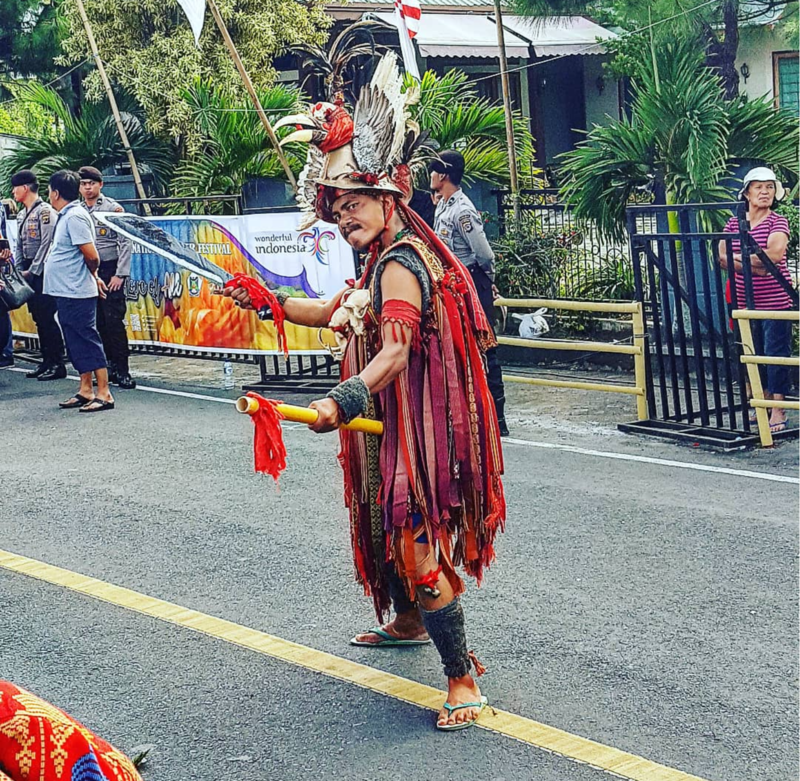 Until well into the 19th century the Minahasa was made up of rivaling warrior societies that practiced headhunting. Only during ‘Pax Neerlandica’ of the formal colonisation of the Dutch East Indies did the state of permanent internal warfare and the practice of headhunting subside.
Until well into the 19th century the Minahasa was made up of rivaling warrior societies that practiced headhunting. Only during ‘Pax Neerlandica’ of the formal colonisation of the Dutch East Indies did the state of permanent internal warfare and the practice of headhunting subside.
According to Minahasa mythology the Minahasans are descendants of Toar and Lumimuut. Initially, the descendants of Toar-Lumimuut were divided into three groups: Makatelu-pitu (three times seven), Makarua-siouw (two times nine) and Pasiowan-Telu (nine times three).
 They multiplied quickly. But soon there were disputes among these people. Their leaders named Tona’as then decided to meet and talk about this. They met in Awuan (north of the Tonderukan hill).
They multiplied quickly. But soon there were disputes among these people. Their leaders named Tona’as then decided to meet and talk about this. They met in Awuan (north of the Tonderukan hill).
That meeting was called Pinawetengan u-nuwu (dividing of language) or Pinawetengan um-posan (dividing of ritual). At that meeting the descendants were divided into three groups named Tonsea, Tombulu, and Tontemboan corresponding to the groups mentioned above. At the place where this meeting took place a memorial stone called Watu Pinabetengan (Stone of Dividing) was then built. It is a favourite tourist destination.
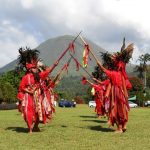
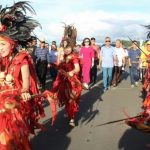
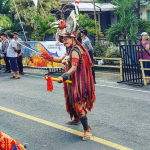

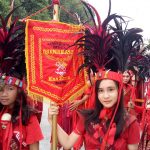

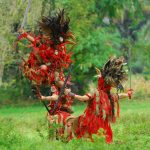
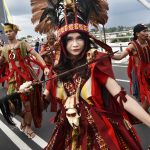
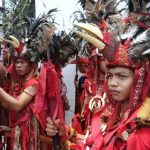
 Culture
Culture
Ancient Minahasa society was both competitive and egalitarian. Important walian (religious shaman) were often female and Minahasa culture does not show any particular discrimination against women. Important decisions concerning the community were made democratically. Owing to the virtual equality in birth a persons rise in status was mainly dependent on personal achievements and the expression of personal virtues.
 Leadership positions and higher status were acquired via two main mechanisms: the deployment of wealth and the show of bravery. The first was achieved via ‘status selematans’, ceremonial feasts called foso, and the latter originally via successful headhunting.
Leadership positions and higher status were acquired via two main mechanisms: the deployment of wealth and the show of bravery. The first was achieved via ‘status selematans’, ceremonial feasts called foso, and the latter originally via successful headhunting.
Headhunting helped the warrior gain a religious concept called keter, which is similar to the Malay term semangat and means ‘soul/spirit substance’. This spiritual and physical force is expressed as courage, eloquence, virility and fertility.
 Even without the actual practice of headhunting and other old traditions and customs these core elements of original Minahasa culture are still held in high regard. To this day the deployment of wealth, bravery, obstinacy and the eloquence of verbal resistance are important to social mobility in the Minahasa.
Even without the actual practice of headhunting and other old traditions and customs these core elements of original Minahasa culture are still held in high regard. To this day the deployment of wealth, bravery, obstinacy and the eloquence of verbal resistance are important to social mobility in the Minahasa.
Minhasa dead were buried in waruga, a type of sarcophagus, until the practice was outlawed by the Dutch.
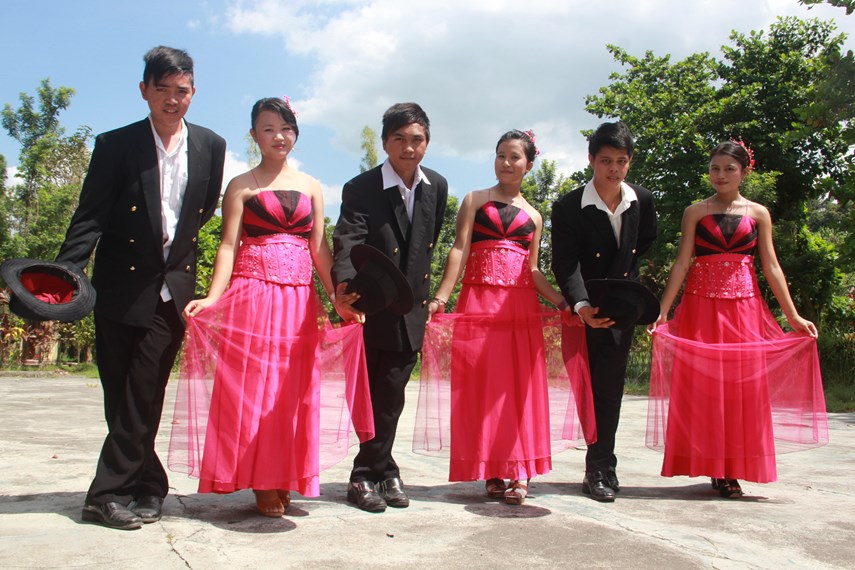 Although after the Dutch came to Minahasa and after the treaty of 1699 between the Dutch and the Minahasan people, most Minahasan people. especially the upperclass and the ones living in Manado, slowly adopted European and Dutch culture and heavily westernized. In the 18th and 19th centuries, the Minahasan people had completely adopted a more European culture, clothing and lifestyle until the revival of ancient Minahasan culture in the late 20th century.
Although after the Dutch came to Minahasa and after the treaty of 1699 between the Dutch and the Minahasan people, most Minahasan people. especially the upperclass and the ones living in Manado, slowly adopted European and Dutch culture and heavily westernized. In the 18th and 19th centuries, the Minahasan people had completely adopted a more European culture, clothing and lifestyle until the revival of ancient Minahasan culture in the late 20th century.
Although even until today there are some Minahasan who are more Dutch or European cultured. This makes the Minahasan people a very unique group of people among other Indonesians. And it was described that Minahasa itself is a lonely outpost of Western culture and Christianity, a bastion of loyalty to colonial power. Where Minahasan are actually the subject of a study called Stranger King theory.
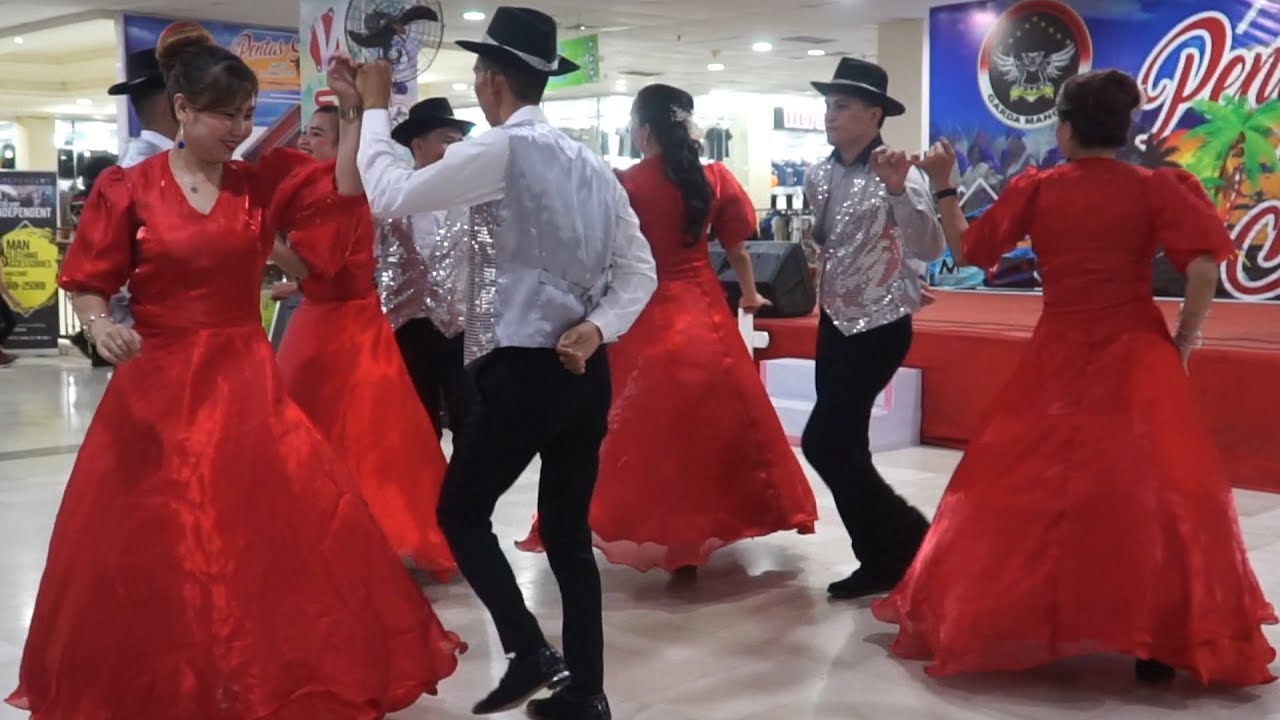 Art
Art
Dance. A kabasaran war dance, performed at a parade, 2006 Kabasaran is the fierce and famous Minahasan wardance which reminds of the old Minahasa warrior societies. The dancers wear red garments which in the old times was a color exclusive for the accomplished headhunter. This dance is similar to the Moluccan cakalele wardance.
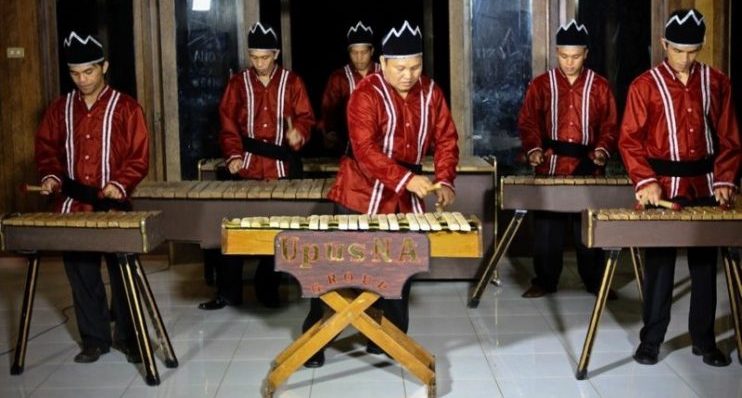 Another famous dance is the katrili dance that’s still widely performed in minahasa. The katrili dance is originally a Portuguese folk dance and was adopted into minahasan society.
Another famous dance is the katrili dance that’s still widely performed in minahasa. The katrili dance is originally a Portuguese folk dance and was adopted into minahasan society.
The dancer would use a European style ball dress for the ladies and usually a formal European attire for the men, usually consisting of a plain shirt a vest dress or dancing shoes and a wide brimmed hat (a fedora or a slouch hat).
Music. Native Minahasan music includes percussions such as gong, drum and kolintang. Minahasa music is highly influenced by that of the European colonials; their festivals feature large marching bands made up of clarinets, saxophones (source), trumpets, trombones, and tubas, all constructed out of local bamboo, which form the basis of a song genre known as musik bambu.
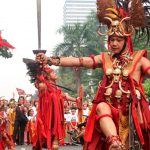
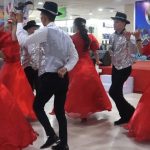
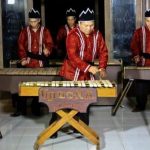

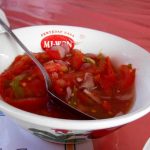


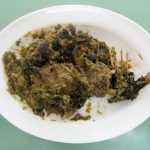
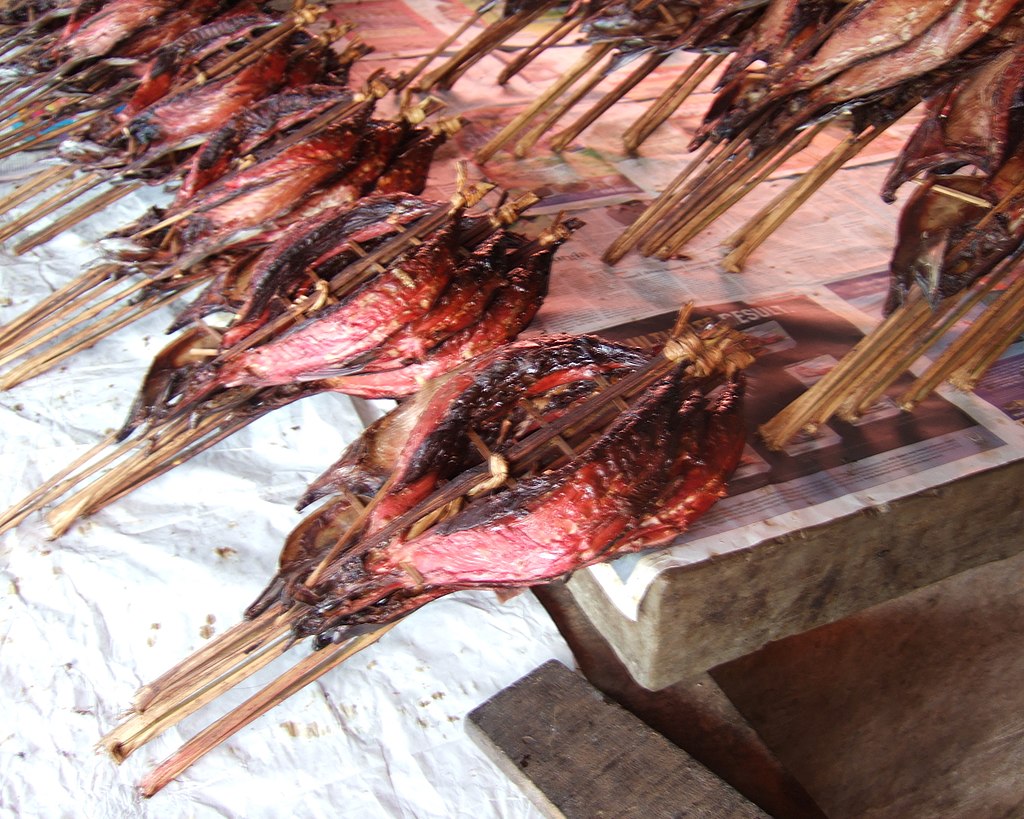 Cuisine
Cuisine
Minahasan cuisine is very spicy, and can feature ingredients not typically found in other parts of Indonesia. For example, dog (RW, short for rintek wuuk, or “fine hair” in Tontemboan), cat (tusa’, also known as eveready because of the cat logo used by the battery), forest rat, and fruit bat (paniki), python snake or the local called it patola are commonly eaten.
Other than these exotic meats, seafoods are abundant in Manado and other port cities in North Sulawesi. Popular fish such as cakalang (skipjack tuna), tuna, red snapper, and tude (mackerel). Cakalang fufu, the smoked skipjack tuna is a popular dish of Bitung fishing town.
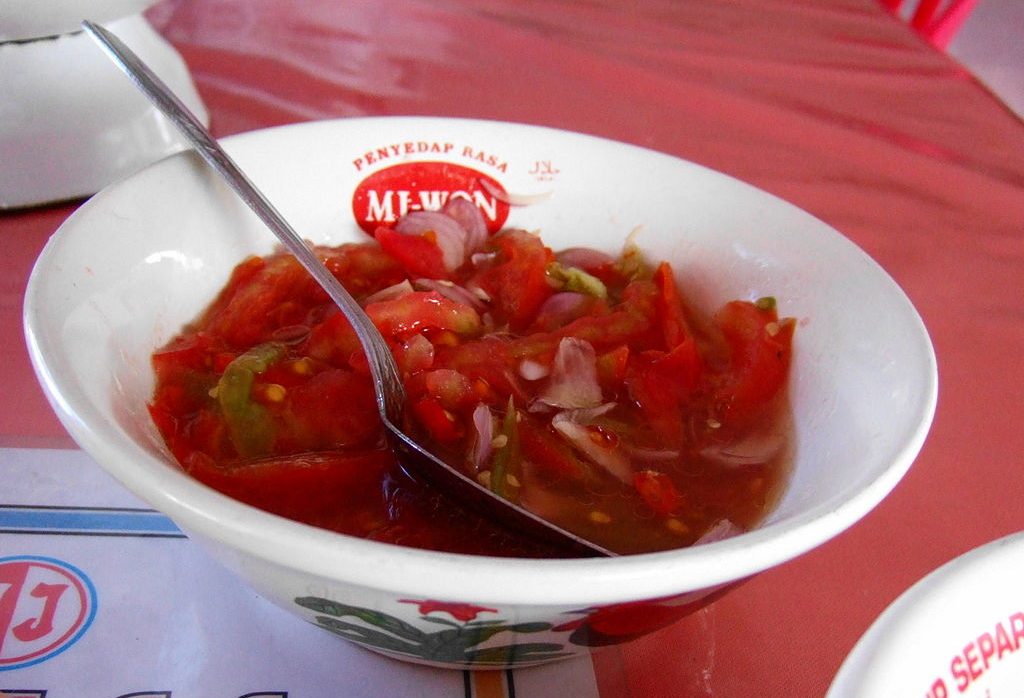 The provincial capital Manado is often referred to as Kota Tinutuan, in reference to a popular local dish: a rice porridge made with corn, smoked fish, greens, and chilies. Known outside the province as Bubur Manado, tinutuan is supposed to improve health and vitality.
The provincial capital Manado is often referred to as Kota Tinutuan, in reference to a popular local dish: a rice porridge made with corn, smoked fish, greens, and chilies. Known outside the province as Bubur Manado, tinutuan is supposed to improve health and vitality.
Another popular minahasan cuisine is rica-rica and dabu-dabu. Rica-rica is dishes usually fish or meat, cooked in spicy red chili, shallots, garlic, and tomato, while dabu-dabu is a type of condiment similar to sambal, made of chopped chilli, shallots, and green tomato mixed with a little vinegar or lime juice. Another vegetables is sayur bunga papaya, papaya flower buds sauteed with shallots, chilli and green tomato.
